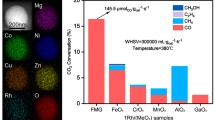Abstract
A series of Cu–Co ferrites with the general formula Cu1-x Co x Fe2O4 (x = 0, 0.25, 0.50, 0.75 and 1.0) was prepared by a low-temperature hydroxide coprecipitation route. The catalyst systems were characterized by adopting various physicochemical techniques. The acid–base properties were studied in detail, and the catalytic activity as well as the selectivity for oxidative dehydrogenation of ethylbenzene was compared for various compositions. FTIR adsorption of pyridine is carried out to understand the relative acidity of various compositions of the systems. IR studies of spinel surface with adsorbed CO2 and adsorption studies of electron acceptors such as 7,7,8,8-tetracyanoquinodimethane, 2,3,5,6-tetrachloro-1-4-benzoquinone and p-dinitrobenzene are carried out to evaluate the nature of basic sites and the strength and distribution of electron donor sites present on the spinel surface. It is found that acidity (basicity) of the Cu1-x Co x Fe2O4 spinel system increases (decreases) from x = 0 to 1. A good correlation was found between the activity for this reaction and the surface acid–base properties of the catalysts. Intermediate compositions show better catalytic performance, among which x = 0.50 is superior and demonstrates an intermediate acid–base character. It was observed that dehydrogenation of ethylbenzene to styrene proceeds mainly on an acid–base pair site.
Similar content being viewed by others
References
E. H. Lee, Catal. Rev. 8 (1973) 285.
B. Delmon, P. A. Jacobs and G. Poncelet, Preparation of Catalysts II (Elsevier, Amsterdam, 1979) pp. 293-305.
D. E. Stobbe, F. R. Van Buren, M. S. Hoogenraad, A. J. Van Dillen and J. W. Geus, J. Chem. Soc., Faraday Trans. 87 (1991) 1639.
F. J. O'Hara, U.S. Patent 3,904,552 (1975).
T. Hirano, Appl. Catal. 28 (1986) 119.
J-H. Wu, C-S. Chwg and I. Wang, Appl. Catal. 18 (1985) 295.
I. Wang, W-F. Chang, R-J. Shiau, J-C. Wu and C-S. Chung, J. Catal. 83 (1983) 438.
I. Wang, J-C. Wu and C-S. Chung, Appl. Catal. 16 (1985) 89.
H. H. Kung and M. C. Kung, J. Phys. Chem. 84 (1980) 383.
W. L. Kehl and R. J. Rennard, U.S. Patent 3,450,787 (1969).
R. J. Rennard and W. L. Kehl, J. Catal. 21 (1971) 282.
S. Velu, K. Suzuki, M. Okazaki, M. P. Kapoor, T. Osaki and F. Ohashi, J. Catal. 194 (2000) 373.
E. J. W. Verwey and E. L. Herlman, J. Chem. Phys. 15 (1947) 174.
K. Balasubramanian and V. Krishnasamy, Indian J. Chem. 21A (1982) 813.
W. S. Chen, M. D. Lee and J. F. Lee, Appl. Catal. 83 (1992) 201.
C. S. Narasimhan and C. S. Swamy, Appl. Catal. 2 (1982) 315.
M. John Jebarathinam, M. Eswaramoorthy and V. Krishnasamy, Appl. Catal. A: Gen. 145 (1996) 57.
K. Sreekumar, M. Thomas, T. M. Jyothi, M. D. Biju, S. Suganan and B. S. Rao, Polish J. Chem. 74 (2000) 509.
T. Mathew, N. R. Shiju, B. B. Tope, S. G. Hegde, B. S. Rao and C. S. Gopinath, Phys. Chem. Chem. Phys. 4 (2002) 4260.
E. Prince and R. G. Treuting, Acta. Crystallogr. 9 (1956) 1025.
J. Smith and H. P. J. Wijn, Adv. Electron. Electronphys. 6 (1954) 83.
G. H. Jonker, J. Phys. Chem. Solids 9 (1959) 165.
N. F. M. Henry, J. Lipson and W. A. Wooster, The Interpretation of X-Ray Diffraction Photographs (Macmillan and Co Ltd., London, 1951).
P. Tarte, Spectrochim. Acta. 19 (1965) 49.
J. Preudhomma and P. Tarte, Spectrochim. Acta, Part A27 (1971) 961.
R. D. Waldron, Phys. Rev. 99 (1955) 1727.
W. B. White and B. A. De Angelis, Spectrochim Acta, Part A23 (1967) 985.
K. Lazar, T. Mathew, Z. Koppany, J. Megyeri, V. Samuel, S. P. Mirajkar, B. S. Rao, and L. Guczi, Phys. Chem. Chem. Phys. 4 (2002) 3530.
T. Mathew, N. R. Shiju, K. Sreekumar, B. S. Rao and C. S. Gopinath, J. Catal. 210 (2002) 405.
J. P. Jacobs, A. Maltha, J. R. H. Reintjes, T. Drimal, V. Ponec and H. H. Brogersma, J. Catal. 147 (1994) 294.
R. Philipp and K. Fujimoto, J. Phys. Chem. 96 (1992) 9035.
K. Nakamoto, Infrared and Raman Spectra of Inorganic and Coordination Compounds, 3rd ed. (Wiley, New York, 1978) p. 243.
C. Morterra, G. Ghiotti, F. Boccuzzi and S. Coluccia, J. Catal. 51 (1978) 299.
A. Krause, Sci. Pharm. 38 (1970) 266.
Author information
Authors and Affiliations
Corresponding author
Rights and permissions
About this article
Cite this article
Mathew, T., Malwadkar, S., Pai, S. et al. Oxidative Dehydrogenation of Ethylbenzene over Cu1-x Co x Fe2O4 Catalyst System: Influence of Acid–Base Property. Catalysis Letters 91, 217–224 (2003). https://doi.org/10.1023/B:CATL.0000007158.88722.5e
Issue Date:
DOI: https://doi.org/10.1023/B:CATL.0000007158.88722.5e




